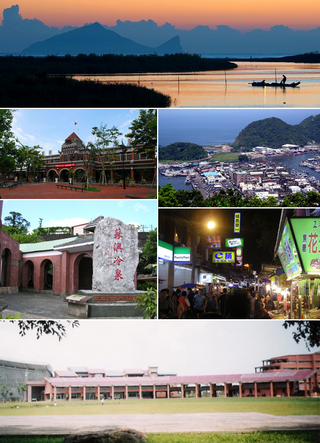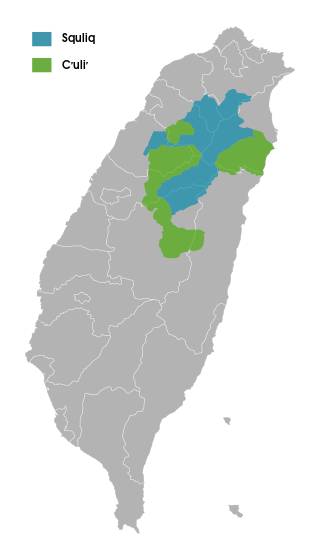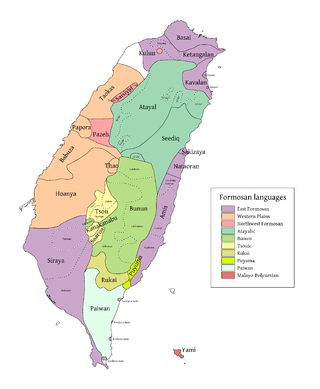
Taiwanese indigenous peoples, also known as Formosans, Native Taiwanese or Austronesian Taiwanese, and formerly as Taiwanese aborigines, Takasago people or Gaoshan people, are the indigenous peoples of Taiwan, with the nationally recognized subgroups numbering about 600,303 or 3% of the island's population. This total is increased to more than 800,000 if the indigenous peoples of the plains in Taiwan are included, pending future official recognition. When including those of mixed ancestry, such a number is possibly more than a million. Academic research suggests that their ancestors have been living on Taiwan for approximately 15,000 years. A wide body of evidence suggests that the Taiwanese indigenous peoples had maintained regular trade networks with numerous regional cultures of Southeast Asia before the Han Chinese colonists began settling on the island from the 17th century, at the behest of the Dutch colonial administration and later by successive governments towards the 20th century.

Hsinchu County is a county in north-western Taiwan. The population of the county is mainly Hakka; with a Taiwanese aboriginal minority in the southeastern part of the county. Zhubei is the county seat, where the government office and county office is located. A portion of the Hsinchu Science Park is located in Hsinchu County.

Miaoli County is a county in western Taiwan. Miaoli is bordered by Hsinchu County and Hsinchu City to the north, Taichung to the south, and the Taiwan Strait to the west. Miaoli is classified as "central Taiwan" by the National Development Council and "northern Taiwan" by the Taiwan Central Weather Bureau. Miaoli City is the capital of the county, and is also known as "Mountain Town", owing to the number of mountains nearby, making it a destination for hiking.

Taitung County is the third largest county in Taiwan, located primarily on the island's southeastern coast and also including Green Island, Orchid Island and Lesser Orchid Island. The seat is located in Taitung City.

Yilan County, alternately spelled I-lan, is a county in northeastern Taiwan. Yilan is the northernmost county on the island of Taiwan, with a population 450,031. Its seat is located in Yilan City.

The Atayal, also known as the Tayal and the Tayan, are a Taiwanese indigenous people. The Atayal people number around 90,000, approximately 15.9% of Taiwan's total indigenous population, making them the third-largest indigenous group. The preferred endonym is "Tayal", although the Taiwanese government officially recognizes them as "Atayal".

The Atayal language is an Austronesian language spoken by the Atayal people of Taiwan. Squliq and C’uli’ (Ts’ole’) are two major dialects. Mayrinax and Pa’kuali’, two subdialects of C’uli’, are unique among Atayal dialects in having male and female register distinctions in their vocabulary.
The term "Taiwanese people" has various interpretations. It may generally be considered the people living on the island of Taiwan who share a common culture, ancestry and speak Mandarin, Hokkien, Hakka, or indigenous Taiwanese languages as a mother tongue. Taiwanese people may also refer to the indigenous peoples of the areas under the control of the Government of the Republic of China since 1945, including Kinmen and Matsu Islands that collectively form its streamlined Fujian Province. However, the inhabitants of Kinmen and the Matsu Islands themselves may not consider the "Taiwanese" label to be accurate as they are a part of Fujian and not Taiwan. They have a distinctive identity from that of the Taiwanese; viewing themselves as Kinmenese or Matsunese, respectively, or as simply Chinese.

Saisiyat is the language of the Saisiyat, a Taiwanese indigenous people. It is a Formosan language of the Austronesian family. It has approximately 4,750 speakers.

The languages of Taiwan consist of several varieties of languages under the families of Austronesian languages and Sino-Tibetan languages. The Formosan languages, a geographically designated branch of Austronesian languages, have been spoken by the Taiwanese indigenous peoples for thousands of years. Owing to the wide internal variety of the Formosan languages, research on historical linguistics recognizes Taiwan as the Urheimat (homeland) of the whole Austronesian languages family. In the last 400 years, several waves of Han emigrations brought several different Sinitic languages into Taiwan. These languages include Taiwanese Hokkien, Hakka, and Mandarin, which have become the major languages spoken in present-day Taiwan.

The island of Taiwan, together with the Penghu Islands, became an annexed territory of Japan in 1895, when the Qing dynasty ceded Fujian-Taiwan Province in the Treaty of Shimonoseki after the Japanese victory in the First Sino-Japanese War. The consequent Republic of Formosa resistance movement on Taiwan was defeated by Japan with the capitulation of Tainan. Japan ruled Taiwan for 50 years. Its capital was located in Taihoku (Taipei) led by the Governor-General of Taiwan.

The Council of Indigenous Peoples, formerly known as the Council of Aboriginal Affairs, is a ministry-level body under the Executive Yuan in Taiwan. It was established to serve the needs of the country's indigenous populations as well as a central interface for the indigenous community with the government.

The Qing dynasty ruled over the island of Taiwan from 1683 to 1895. The Qing dynasty sent an army led by general Shi Lang and defeated the Ming loyalist Kingdom of Tungning in 1683. Taiwan was then formally annexed in April 1684.

The population of Taiwan is approximately 23.35 million as of April 2023.

The Beipu Incident, or the Beipu Uprising, in 1907 was the first instance of an armed local uprising against the Japanese rule of the island of Taiwan. In response to oppression of the local population by the Japanese authorities, a group of insurgents from the Hakka subgroup of Han Chinese and Saisiyat indigenous group in Hoppo, Shinchiku Chō, attacked Japanese officials and their families. In retaliation, Japanese military and police killed more than 100 Hakka people. The local uprising was the first of its kind in Taiwan under Japanese rule, and led to others over the following years.

Plains indigenous peoples, also known as Pingpu people and previously as plain aborigines, are Taiwanese indigenous peoples originally residing in lowland regions, as opposed to Highland indigenous peoples. Plains indigenous peoples consist of anywhere from eight to twelve individual groups, or tribes, rather than being a single ethnic group. They are part of the Austronesian family. Beginning in the 17th century, plains indigenous peoples have been heavily influenced by external forces from Dutch, Spanish, and Han Chinese colonization of Taiwan. This ethnic group has since been extensively assimilated with Han Chinese language and culture; they have lost their cultural identity, and it is almost impossible without careful inspection to distinguish plains indigenous peoples from Taiwanese Han people.
Han Taiwanese, Taiwanese Han, Taiwanese Han Chinese, or Han Chinese are Taiwanese people of full or partial ethnic Han ancestry. According to the Executive Yuan of Taiwan, they comprise 95 to 97 percent of the Taiwanese population, which also includes Austronesians and other non-Han people. Major waves of Han immigration occurred since the 17th century to the end of Chinese Civil War in 1949, with the exception of the Japanese colonial period (1895–1945). Han Taiwanese mainly speak three languages of Chinese: Mandarin, Hokkien and Hakka.

Walis Perin is a Seediq Taiwanese politician. He served four terms in the Legislative Yuan from 1993 to 2005, each time with a different political affiliation. He became a founding member of the Non-Partisan Solidarity Union in 2004, and after losing reelection, was appointed the minister for the Council of Indigenous Peoples in 2005. He stepped down in 2007, and since then has launched two unsuccessful legislative campaigns, in 2012 with the People First Party and 2016, representing the Democratic Progressive Party. In 2018, Walis Perin was appointed to the Control Yuan.

Uyongʉ Yata'uyungana, also known as Uong'e Yatauyungana, Yata Issei (矢多一生), Kao Yi-sheng (高一生), was a Taiwanese Tsou musician and educator of the Tfuya tribe. He served as a local officer and a leader of the indigenous autonomous movement in the early post-war Taiwan.
During the martial law period in Taiwan, a Mandarin monolingual policy was implemented in Taiwan by the Kuomintang. The policy was formulated as a political goal to unite the island. However, the demotion of prior local languages into "dialects" across cultural and educational landscapes resulted in a pushback of the policy and eventually rescinded as Taiwan democratized.
















